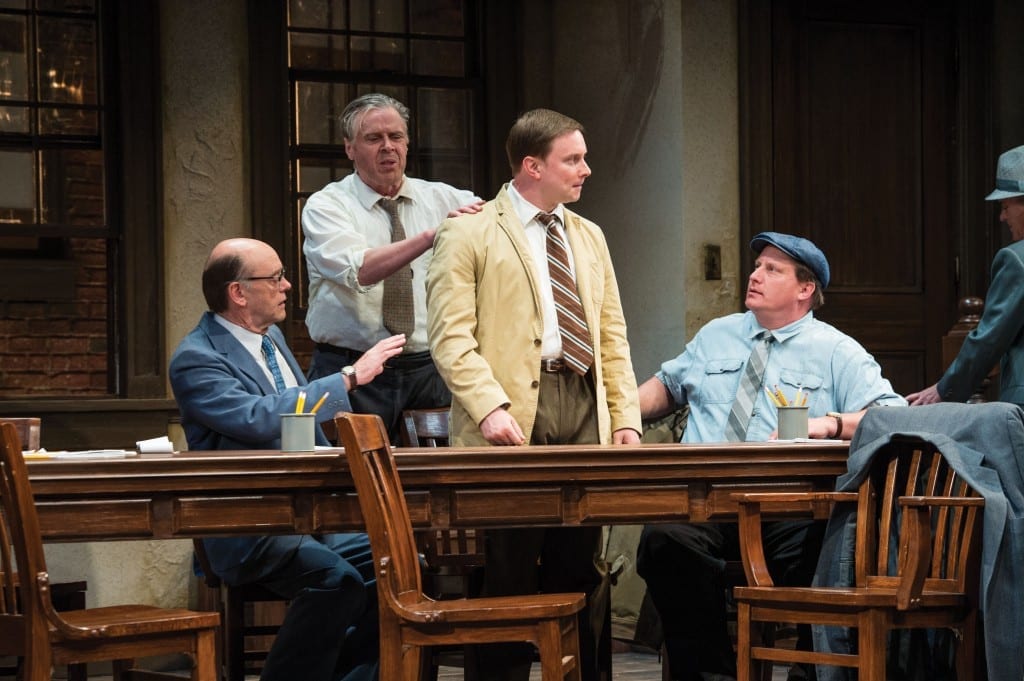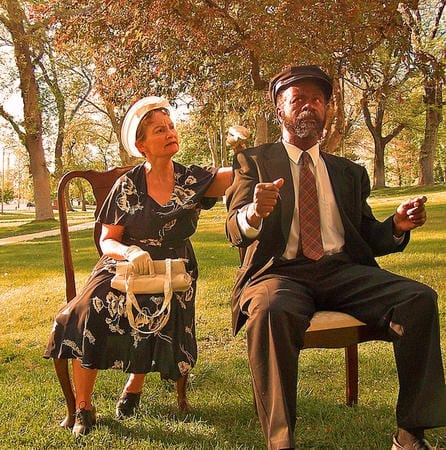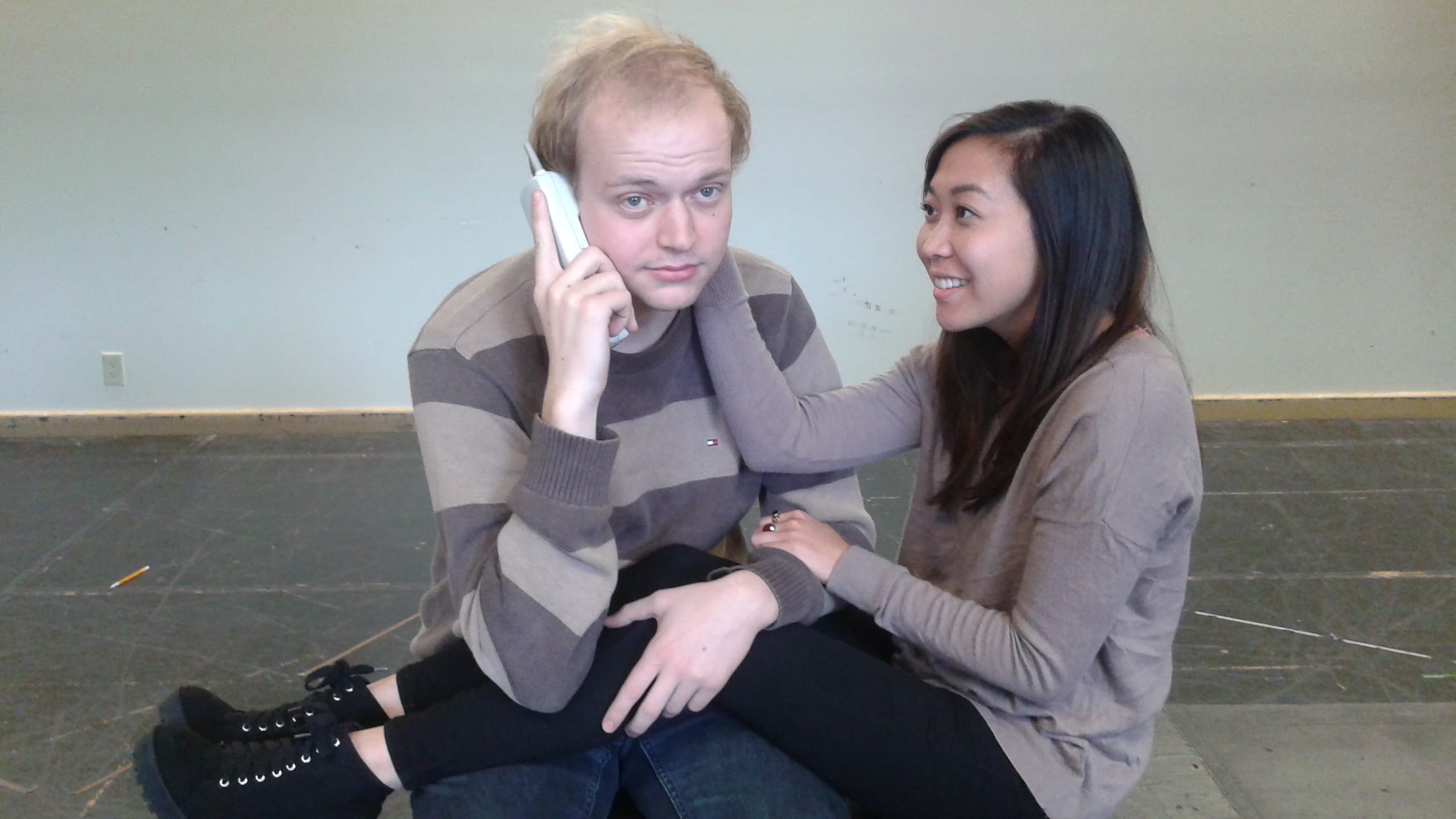CEDAR CITY — For me, the best theatre has always been the type that does more than just entertain. I love a show that tries to improve the audience in some way, or makes them take a hard look at who they are and what they do. The current production of Twelve Angry Men playing at the Utah Shakespeare festival is a great example of a show that does just that. It manages to instruct without being too preachy and accomplishes this through a proven script, powerful acting, and purposeful directing. All of which is capped off with a strong design element.

A. Bryan Humphrey (left) as Juror #4, Max Robinson as Juror #3, Steve Wojtas as Juror #5, and Michael A. Harding as Juror #6 in the Utah Shakespeare Festival’s 2013 production of Twelve Angry Men. (Photo by Karl Hugh. Copyright Utah Shakespeare Festival 2013.)
The show, written by Reginald Rose in the mid 1950’s, centers around a group of jurors who have just entered the deliberation after a three-day murder trial. They are tasked with deciding whether a teenager from the “wrong side” of the town deserves the electric chair for allegedly stabbing his father. The initial vote is 11-1 for guilty and the lone hold-out is Juror #8. The show then begins an interesting character study as Juror #8 systematically defends his position and strives to get others on board with him. As mentioned by director David Ivers in his program note, the show is not so much a study of our judicial system as it is a look into why Americans make the decisions they do and how human beings let their biases influence their actions.

A scene from the Utah Shakespeare Festival’s 2013 production of Twelve Angry Men. (Photo by Karl Hugh. Copyright Utah Shakespeare Festival 2013.)
The show made a strong first impression with the gorgeous set by Jo Winiarski. The jury room was simple with only a long table, twelve chairs, a couple of windows, and a door leading to a very small washroom. This simplicity was deceptive though in the sense that every detail was still accounted for. The style of the chairs, the table, the paint on the walls, the towel dispenser in the washroom, and so on, all seemed to fit into the time period and it transported the audience into the 1950’s.
The set was complemented by the beautiful lighting design by Jaymi Lee Smith. Smith started the show with a very natural light streaming through the windows giving the room an almost hopeful feel. As the show progressed there were a number of extremely subtle shifts in light that mimicked the sun setting. The changes were almost imperceptible and it was fairly shocking when the fluorescent lights above the stage flicked on and I realized how dark it had become “outside.” It was a great effect, and one that also helped to emphasize the descent of the characters deeper and deeper into the muddled case they were dealing with by adding a harshness to the mood with the industrial lights.

Roderick Peeples (left) as Juror #10 and A. Bryan Humphrey as Juror #4 in the Utah Shakespeare Festival’s 2013 production of Twelve Angry Men. (Photo by Karl Hugh. Copyright Utah Shakespeare Festival 2013.)
The most enjoyable part of the evening for me was watching Ivers’s skilled direction. I think this is one of the first shows I have ever seen where the stage pictures and blocking were almost as fun to watch as the actors. Twelve Angry Men never felt stagnant, a feat made more impressive considering that Rose’s script has relatively little action and focuses more on dialogue. Ivers used diverse set of stage pictures to continue giving fresh takes on what is, essentially, the same scene over and over: that of twelve men sitting around a table talking. There were also a number of subtle choices that helped to convey the story to the audience. Sometimes it was the direction a group of actors was facing to let us know who was on whose side. Other times it was an actor who was sitting a little ways apart from the others, reinforcing the fact that this person did not agree with the group. And at all times, each actor was visible. Which was also not an easy task considering the positioning of the chairs around the table. These seem like such common sense choices for a director and yet there are so many productions that neglect these basics that this show was truly refreshing in its nearly flawless execution.
Along with the stage pictures and the movement, the pacing of the show felt just about perfect. Another trap that many directors fall into is not allowing the audience a moment to think and breathe. This could have been a major problem for a show where tempers run high for almost two hours (see title). However, Ivers provided a very well balanced show where the audience was pulled into the fray as the characters argued, but was also allowed to settle down for a second before getting pulled in again. There was also a good shift in the energy of the show as it progressed. In the opening few scenes, there was a lot of jovial bustling around that mirrored the casualness with which the characters were approaching their duties. This was contrasted by the beautiful stillness and quiet of the final few scenes that conveyed to the audience the change that had taken place in the characters and the solemnity with which they now handled the matter.

Roderick Peeples as Juror #10 in the Utah Shakespeare Festival’s 2013 production of Twelve Angry Men. (Photo by Karl Hugh. Copyright Utah Shakespeare Festival 2013.)
The acting in the show was, in a word, professional. From the moment that the actors walked on stage, and the characters entered the jury room, it was extremely apparent that each performer had a distinct understanding of the unique aspects of who their character was. No lines were spoken, but it was apparent in the way each actor responded to the others in the room and the room itself. The cast was strong as an ensemble and each actor seemed to know exactly how their character felt about every other man in the room at every point in the process. My biggest kudos to the cast has to be for their ability to listen to one another. Though the show is mostly about talking through things, there were a number of subtle physical acting choices throughout the cast. I loved watching a juror make a simple movement, such as changing the way they were sitting or where they were standing and watching the jurors next to them react and counter in order to support each other.
The cast had many strong actors and strong voices, but none more so than Juror #3 (Max Robinson) and Juror #8 (Martin Kildare). The relationship between these two was extremely rewarding to watch. Kildare provided an extremely sympathetic portrayal of the juror who holds out against the initial guilty votes. His acting choices were exciting to watch as he systematically tried to convince each juror to see things his way. This ranged from a sweet and genuine approach to the more timid jurors, to the outright fistfight level anger needed for the more stubborn jurors. Kildare was able to handle the transitions believably and naturally. Robinson gave a wonderfully deep performance as Juror #3 that took the audience through feelings of hatred, sympathy, grief, and more. He was another performer who was able to handle the transitions in his character extremely well. The changes in his character, like many of the changes in this show, were very subtle and always supported by the small acting choices he made here and there.
The quality of the acting in this show is to the point where I am unable to come up with any examples of any performance that I disliked, or that I felt wasn’t as strong as the others. I really wish that I could go juror by juror to analyze each performance, but there really isn’t the space, and there is really nothing to say but praise.
The Utah Shakespeare Festival production of Twelve Angry Men was an absolute treat. It was beautiful to look at, had a great ensemble, skilled direction, and entertained while simultaneously instructing. I would venture to say that this show is of equal quality as many of the shows that audience members could see in New York or London. It truly is a world-class theatre production. I would recommend this show to everyone who has the ability to make it to the Shakespeare festival. Have I gushed enough about it? Some might think that I’m being a little too generous here, but in all honesty, I really only have positive things to say about this show. Don’t miss this one.






